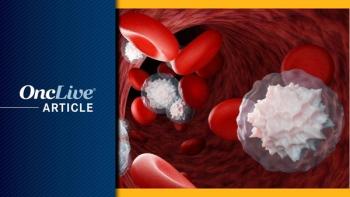
CMP-001 Plus Pembrolizumab Elicits Deep Responses, Reverses PD-1 Resistance in Advanced Melanoma
November 12, 2020 - The combination of CMP-001 intratumoral injection and pembrolizumab was found to reverse PD-1 blockade resistance and elicit durable systemic responses in patients with advanced melanoma.
November 12, 2020 - The combination of CMP-001 (formerly CYT 003 or ARB 1598) intratumoral injection and pembrolizumab (Keytruda) was found to reverse PD-1 blockade resistance and elicit durable systemic responses in patients with advanced melanoma, according to results from a phase 1 CMP-001-001 trial (NCT02680184) presented during the virtual
Results showed that CMP-001 plus pembrolizumab led to a best overall response rate (ORR) per RECIST v1.1 criteria of 23.5% (95% CI, 15.5-33.1), and a best ORR of 27.6% (95% CI, 19.0-37.6) in post-progression responders. Moreover, the median duration of response (DOR) was 19.9 months in patients who experienced disease progression on previous PD-1 blockade.
“Intratumoral CMP-001 with pembrolizumab, we feel, reversed the resistance to PD-1 blockade and showed durable systemic responses,” said Mohammed Milhem, MBBS, Holden chair of Experimental Therapeutic, associate director of Clinical Research at the Holden Comprehensive Cancer Center, director of the Melanoma Program, chief Section of Oncology within the Department of Medicine, and clinical professor at the University of Iowa Health Care. “It’s important to note that this is a phase 1 trial…but these are relatively good data to show at this meeting.”
Immunotherapy has significantly improved outcomes for patients with cancer, but most patients still do not respond to anti–PD-1/PD-L1 therapies. Moreover, many patients will still experience progressive disease despite treatment. Patients with advanced melanoma who progress on anti–PD-1/PD-L1 therapies have very few treatment options available. To fill this need, investigators launched the CMP-001-001 trial to determine whether the CpG-A toll-like receptor 9 (TLR9) agonist CMP-001 can represent a potential new therapy for this patient population.
CMP-001 is packaged inside of an immunogenic virus-like particle (VLP) that generates the production of anti-VLP antibodies, which then activates plasmacytoid dendritic cells. This leads to the induction of interferon-α and tumor regression, as demonstrated in preclinical tumor models.
To be eligible for enrollment, patients needed to be aged 18 years of age or older and have histologically confirmed metastatic nonuveal melanoma amenable to intratumoral injection. Patients must have achieved stable disease or experienced disease progression after 12 weeks or more weeks on a previous PD-1 inhibitor. Moreover, patients needed to have measurable disease per RECIST v1.1 criteria and an ECOG performance status of 0 or 1.
Patients who had received previous treatment with an anti–CTLA-4 or investigational therapy within 30 days before study start, those who required more than 10 mg of systemic corticosteroids per day, those with grade 4 autoimmune disorders from immunotherapy, or those with active central nervous system metastases were excluded from the study.
The first part of the trial utilized a standard 3+3 dose escalation (n = 44) and dose expansion design (n = 115). The doses analyzed were 1 mg, followed by 3 mg, 5 mg, 7.5 mg, and 10 mg. Investigators examined 2 schedules of CMP-001 administration: 7 doses weekly (arm A) or 2 doses weekly (arm B). The drug was then given every 3 weeks thereafter until discontinuation. The second part of the study examined CMP-001 monotherapy in a parallel cohort (n = 40).
CMP-001 was delivered in 2 different PS20 concentrations in part 1 of the trial. Ninety-eight patients comprised the PS20 A arm (PS20 of 0.01%); 44 of these patients were part of the dose escalation portion of the trial and 54 were from the expansion portion. Sixty-one patients comprised the PS20 B arm (PS20 of 0.00167%); these patients were all from the expansion portion of the research.
The primary objective in part 1 of the study was to identify the recommended phase 2 dose and schedule of CMP-001 when administered in combination with pembrolizumab in patients with advanced disease. The primary goal of part 2 of the trial was to determine the safety of CMP-001 when given as a single agent (n = 40). Key secondary objectives included antitumor activity of the combination and the monotherapy, the safety of the combination, and the pharmacodynamics of the combination.
The median patient age was 64 years (95% CI, 30-90) in part 1 of the study examining the combination and 68 years (95% CI, 30-89) in part 2, which examined the monotherapy. Fifty-six percent (n = 89) of patients were male and 44.0% (n = 70) were female in the first half of the study, while 65.0% (n = 26) were male and 35.0% were female (n = 14) in part 2.
The majority of patients in both parts of the trial were white. In part 1, 65.4% (n = 104) and 34.6% (n = 55) of patients who received the combination had an ECOG performance status of 0 or 1, respectively. In part 2, half of the patients who received the monotherapy had an ECOG performance status of 0, while the other half had a status of 1. In both parts of the trial, the number of previous therapies received was 2.
Moreover, all patients had received prior treatment with an anti–PD-1 agent in both parts of the study. In part 1, 46.5% (n = 74) of patients had received prior ipilimumab (Yervoy), while 42.5% (n = 17) previously received the agent in part 2.
Additional results showed that when broken down into PS20 A and PS20 B subgroups, the best ORR achieved with the combination was 23.5% and 11.5% (95% CI, 4.8-22.3), respectively. The best ORR reported with the monotherapy was 17.5% (95% CI, 7.3-32.8). When looking at post–progressive disease responders, the best ORR reported with the combination in the PS20 A group is 27.6% (95% CI, 19.0-37.6) and 16.4% (95% CI, 8.2-28.1) in PS20 B group. These data were not available for the monotherapy group.
Additionally, 7 patients in the PS20 A cohort experienced a CR versus 1 patient in the PS20 B cohort and no patients in the monotherapy cohort. Sixteen patients in the PS20 A cohort experienced a PR versus 6 patients in the PS20 B cohort and 7 patients in the monotherapy cohort. Stable disease was achieve in 16 patients, 18 patients, and 13 patients in each respective cohort. Disease progression was observed in 47 patients in the PS20 A group, 28 patients in the PS20 B group, and 20 patients in the monotherapy group. The median DOR with the CMP-001 monotherapy was 5.6 months.
Additionally, treatment with CMP-001 was found to result in notable changes in tumor size. “[Regarding] best changes in tumor size with CMP-001 PS20A plus pembrolizumab, we did see some deep responses, as well as some CRs,” said Milhem. “We saw responses in the monotherapy cohort, as well.”
Notably, an abscopal effect was observed in responders who had non-injected target lesions, according to Milhem.
The most common any-grade toxicities reported with the combination in part 1 of the study included chills (74.8%; n = 119), pyrexia (61.6%; n = 98), and fatigue (54.7%; n = 87). The most frequently reported grade 3 adverse effects (AEs) in those given the CMP-001/pembrolizumab combination included hypotension (6.3%; n = 10) and hypertension (5%; n = 8), while grade 4 AEs included hypotension (0.6%; n = 1), aspartate aminotransferase increase (0.6%; n = 1), and alanine aminotrasferase increase (0.6%; n = 1).
The most common any-grade AEs experienced with CMP-001 monotherapy included chills (52.5%; n = 21), nausea (47.5%; n = 19), and pyrexia (45.0%; n = 18). The most commonly experienced toxicity that was grade 3 in severity was hypotension (5%; n = 2). Here, no grade 4 AEs were reported.
“CMP-001 in combination with an anti–PD-1 inhibitor warrants further investigation in patients with melanoma,” Milhem concluded.
References
- Milhem M, Zakharia Y, Davar D, et al. Intratumoral injection of CMP-001, a toll-like (TLR9) receptor agonist, in combination with pembrolizumab reversed programmed death receptor 1 (PD-1) blockade resistance in advanced melanoma. Presented at: 2020 SITC Annual Meeting; November 9-14, 2020; Virtual. Accessed: November 10, 2020.

























































































